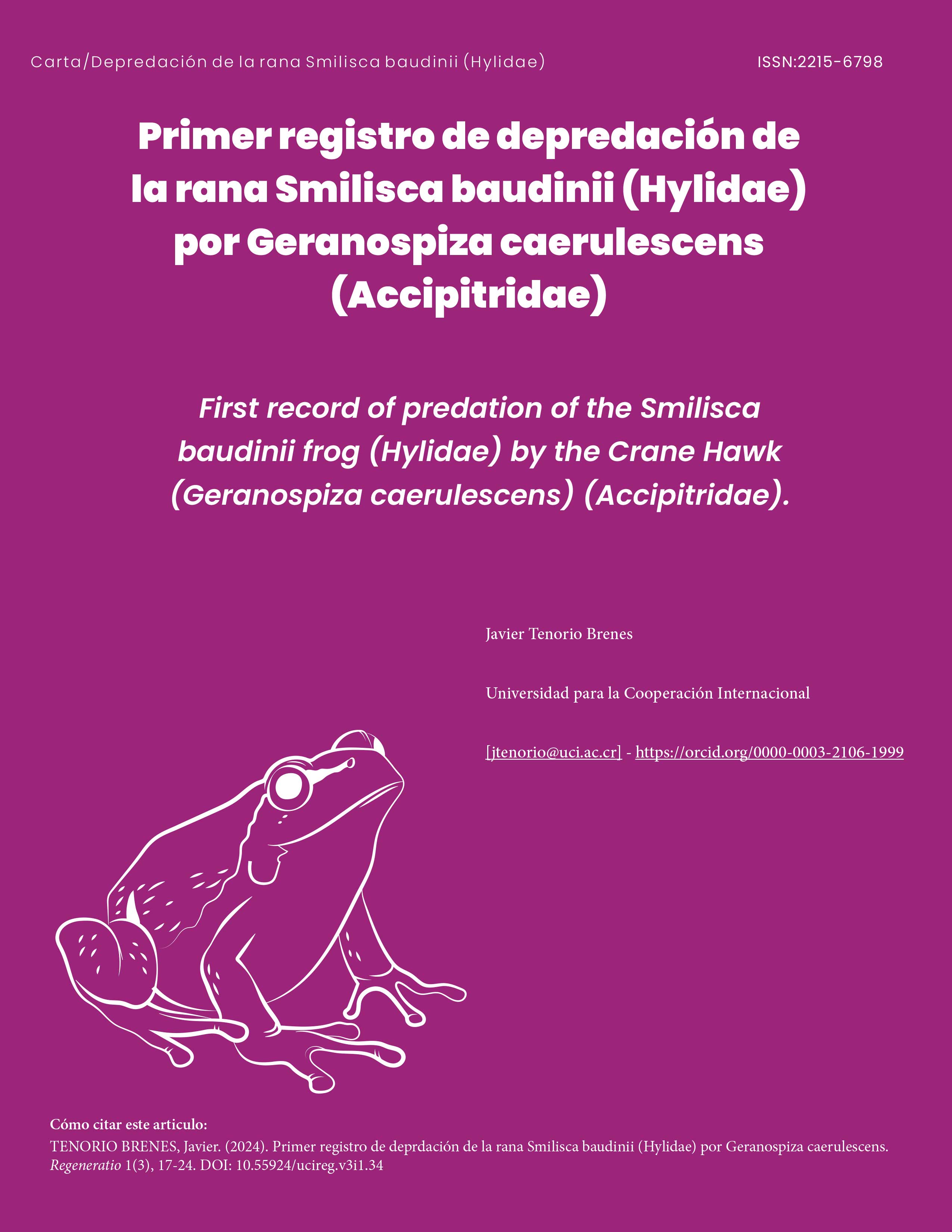First record of predation of the Smilisca baudinii frog (Hylidae) by the Crane Hawk (Geranospiza caerulescens) (Accipitridae).
DOI:
https://doi.org/10.55924/ucireg.v3i1.34Keywords:
regeneration; smilisca baudinni; geranospiza caerulescens; trophic interaction; biodiversity; Costa Rica; Frog Sparrowhawk.Abstract
This study examines the interaction between the Sparrowhawk (Geranospiza caerulescens) and the nocturnal tree frog Smilisca baudinni in the Ventanas residential area, Guanacaste, Costa Rica. A Frog Sparrowhawk was observed hunting and feeding on a tree frog, highlighting the importance of understanding trophic relationships in ecosystems. This finding highlights the need to conserve natural habitats, the region’s endangered biodiversity, and monitor the ecosystem services they provide. In a broader context, the paper emphasizes the urgency of addressing the underlying causes of habitat loss and deforestation in Costa Rica, highlighting regeneration as a crucial strategy to restore ecological balance in the region.
References
Aguilar-López, J. L. (2019). Four cases of prey-predator interaction (anuran-snake) through their geographical distribution. Revista Latinoamericana de Herpetología, 2(1), 31-34.
Barrantes G, Ocampo D, Ramírez-Fernández JD, Fuchs EJ. 2016. Effect of fragmentation on the Costa Rican dry forest avifauna. PeerJ 4:e2422https://doi.org/10.7717/peerj.2422
Bierregaard, R. O., Boesman, P. F. D., Marks, J. S. y Kirwan, G. M. (2020). Crane Hawk (Geranospiza caerulescens), version 1.0. In Birds of the World (J. del Hoyo, A. Elliott, J. Sargatal, D. A. Christie, and E. de Juana, Editors). Cornell Lab of Ornithology. https://doi.org/10.2173/bow.crahaw.01
Bonilla Villalobos, V. (2019). Variación en composición y estructura de la vegetación leñosa de un bosque húmedo premontano transición seca, debido a la actividad agrícola y ganadera. Cuadernos de Investigación UNED, 11(2), 24-37.
Camacho Rojas, D. y Guerrero Vallejos, T. (2015). Estudios preliminares de aves rapaces en la ciudad de Cochabamba, Bolivia. Spizaetus, 19, Junio 2015, 12-17. https://assets.peregrinefund.org/docs/newsletters/spizaetus-19-spanish.pdf
Chassot, O., Valverde-Blanco, A., González-Maya, J. F., Chaudhary, S. y Monge-Arias, G. (2022). Pensando en regeneración: una visión global para la gestión integral de áreas protegidas y conservadas. Regeneratio 1(1), 18-33. DOI:10.55924/ucireg.v1i1.2
de Sá, R. O. (2005). Crisis global de biodiversidad: importancia de la diversidad genética y la extinción de anfibios. Agrociencia, 9(1-2), 513. https://scholarship.richmond.edu/biology-faculty-publications/65/
Ferguson-Lees, J., y Christie, D. A. (2001). Raptors of the world. Houghton Mifflin Harcourt.
Garrigues, R., Camacho-Varela, P, Montoya, M, O’Donnell, P, Ramírez-Alán O y Zook, J. (2022). Lista Oficial de las Aves de Costa Rica – Actualización 2022. Comité de Especies Raras y Registros Ornitológicos de Costa Rica (Comité Científico), Asociación Ornitológica de Costa Rica. https://listaoficialavesdecostarica.wordpress.com/lista-oficial/lista-oficial-online/
Holdridge, L. R. (1947). Determination of world plant formations from simple climatic data. Science, 105(2727), 367-368.
Janzen, D. H. y Hallwachs, W. (2016). Conservación de la biodiversidad su historia y su futuro en Costa Rica: El caso del Área de Conservación Guanacaste (ACG). En M. Kapelle (Ed.), Costa Rican Ecosystems (pp. 290-341). Chicago and London: The University of Chicago Press
Jiménez-Montero, R. (2021). Composición y estructura de anuros en el Parque Nacional La Cangreja, cantón de Puriscal (San José, Costa Rica). Biocenosis, 32(2).
Leenders, T. (2016). Amphibians of Costa Rica: a field guide. Cornell University Press.
Ojeda, R. A. (2014). Acerca del estudio de la historia natural. Mastozoología neotropical, 21(1), 5-8.
Reyes, D. (2012). Análisis de los procesos de restauración pasiva para un bosque seco tropical en la estación experimental forestal Horizontes, Guanacaste, Costa Rica. [Tesis de Licenciatura no publicada]. Instituto Tecnológico de Costa Rica.
Savage, J. M. (2002). The amphibians and reptiles of Costa Rica: a herpetofauna between two continents, between two seas. University of Chicago Press.
Stiles, F. G. y A. F. Skutch. (1995). Guía de aves de Costa Rica. Editorial INBio.
Sutter, J., Martínez A, W. E., Oliva T, F., Oswaldo J, N., y Whitacre, D. F. (2001). Diet and hunting behavior of the crane hawk in Tikal National Park, Guatemala. The Condor, 103(1), 70-77.
Tenorio, J. y De la O, J. (2018). Primer registro de anidación del Gavilán de Ciénaga (Busarellus nigricollis) (Accipitriformes: Accipitridae) en Costa Rica. Spizaetus, 2(26), 9-13.
Tenorio, J., Abarca-Fallas, V. y Ramírez-Allan, O. (2020). Migración del Gavilán Piquiganchudo (Chondrohierax uncinatus) en Kèködi,Costa Rica. Spizaetus, 1(29), 14-18.
Tewksbury, J. J., Anderson, J. G., Bakker, J. D., Billo, T. J., Dunwiddie, P. W., Groom, M. J., ... y Wheeler, T. A. (2014). Natural history’s place

Additional Files
Published
How to Cite
Issue
Section
Categories
License
Copyright (c) 2024 adminuci adminuci

This work is licensed under a Creative Commons Attribution-NonCommercial-ShareAlike 4.0 International License.
Contributions to the journal are made under the terms of the Creative Commons Attribution-NonCommercial-NoDerivatives 4.0 International License (CC BY-NC-ND 4.0).
The use of this type of license grants a user permission to share — copy and redistribute the material in any medium or format, as long as:
- Proper attribution or recognition is given to the author(s) of the licensed material and any other person designated for attribution or recognition, in any reasonable manner requested by the Licensor.
- A link to the license is provided, and it is indicated if changes have been made. This can be done in any reasonable manner, but not in a way that suggests that you or your use are endorsed by the Licensor.
- The material is not used for commercial purposes.
- The original content of the material is not modified. If remixing, transforming, or creating from the material, the modified material cannot be distributed.






